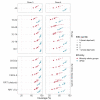Factors associated with COVID-19 vaccine uptake in people with kidney disease: an OpenSAFELY cohort study
- PMID: 36720568
- PMCID: PMC9890277
- DOI: 10.1136/bmjopen-2022-066164
Factors associated with COVID-19 vaccine uptake in people with kidney disease: an OpenSAFELY cohort study
Abstract
Objective: To characterise factors associated with COVID-19 vaccine uptake among people with kidney disease in England.
Design: Retrospective cohort study using the OpenSAFELY-TPP platform, performed with the approval of NHS England.
Setting: Individual-level routine clinical data from 24 million people across GPs in England using TPP software. Primary care data were linked directly with COVID-19 vaccine records up to 31 August 2022 and with renal replacement therapy (RRT) status via the UK Renal Registry (UKRR).
Participants: A cohort of adults with stage 3-5 chronic kidney disease (CKD) or receiving RRT at the start of the COVID-19 vaccine roll-out was identified based on evidence of reduced estimated glomerular filtration rate (eGFR) or inclusion in the UKRR.
Main outcome measures: Dose-specific vaccine coverage over time was determined from 1 December 2020 to 31 August 2022. Individual-level factors associated with receipt of a 3-dose or 4-dose vaccine series were explored via Cox proportional hazards models.
Results: 992 205 people with stage 3-5 CKD or receiving RRT were included. Cumulative vaccine coverage as of 31 August 2022 was 97.5%, 97.0% and 93.9% for doses 1, 2 and 3, respectively, and 81.9% for dose 4 among individuals with one or more indications for eligibility. Delayed 3-dose vaccine uptake was associated with younger age, minority ethnicity, social deprivation and severe mental illness-associations that were consistent across CKD severity subgroups, dialysis patients and kidney transplant recipients. Similar associations were observed for 4-dose uptake.
Conclusion: Although high primary vaccine and booster dose coverage has been achieved among people with kidney disease in England, key disparities in vaccine uptake remain across clinical and demographic groups and 4-dose coverage is suboptimal. Targeted interventions are needed to identify barriers to vaccine uptake among under-vaccinated subgroups identified in the present study.
Keywords: COVID-19; Kidney & urinary tract disorders; Public health.
© Author(s) (or their employer(s)) 2023. Re-use permitted under CC BY. Published by BMJ.
Conflict of interest statement
Competing interests: BG’s work on better use of data in healthcare more broadly is currently funded in part by: the Bennett Foundation, the Wellcome Trust, NIHR Oxford Biomedical Research Centre, NIHR Applied Research Collaboration Oxford and Thames Valley, the Mohn-Westlake Foundation; all Bennett Institute staff are supported by BG's grants on this work. BG is a Non-Executive Director at NHS Digital. EJW holds grants from MRC.
Figures



References
Publication types
MeSH terms
Substances
Grants and funding
LinkOut - more resources
Full Text Sources
Medical
Research Materials
Miscellaneous
